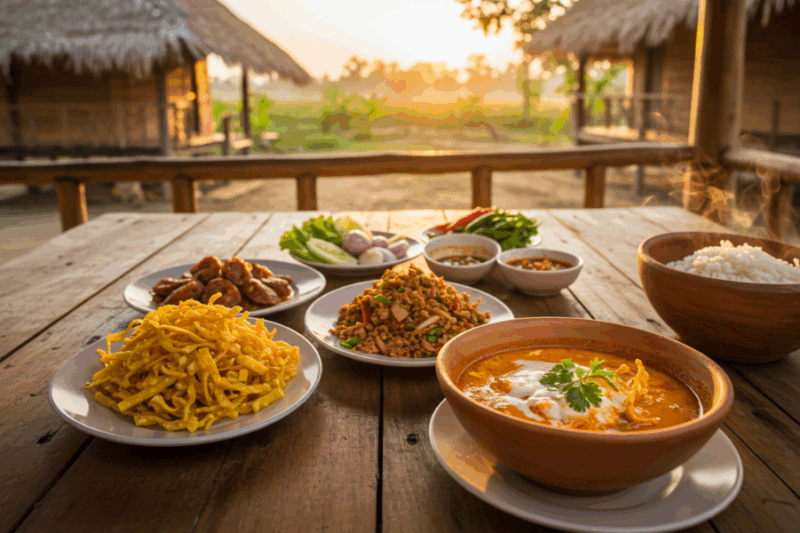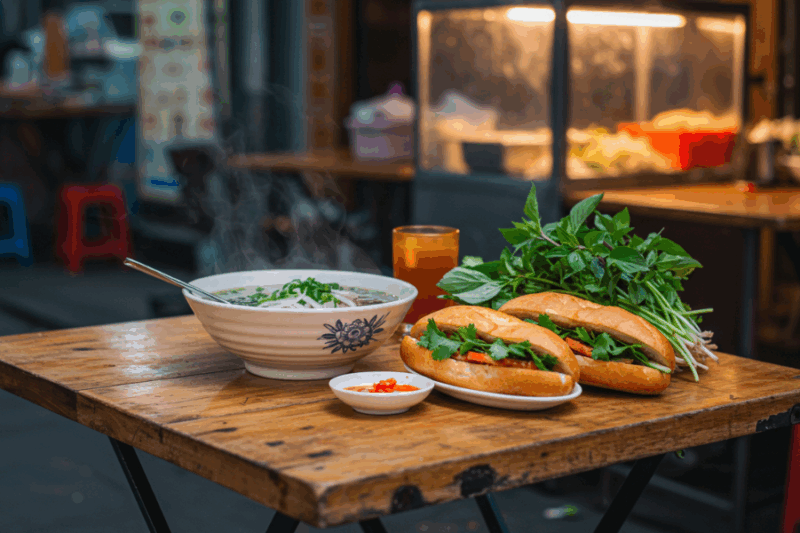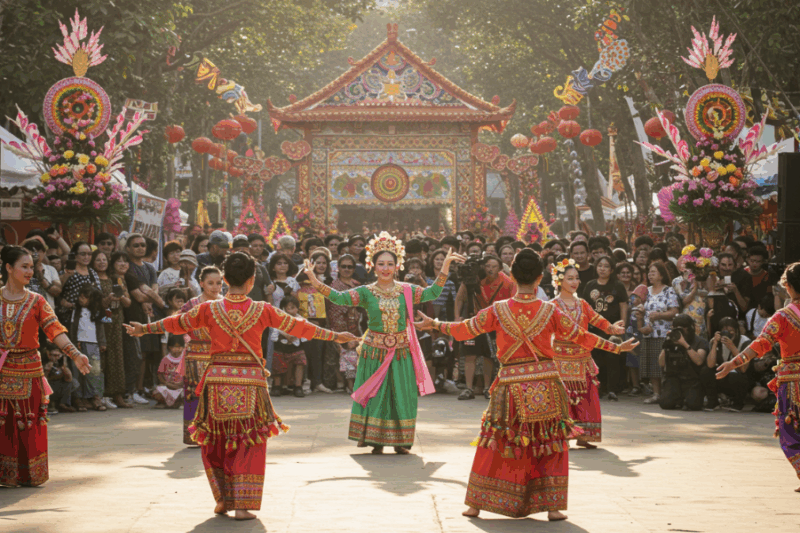Phnom Penh’s street markets are vibrant hubs of Cambodian culture, where locals and travelers mingle amid colorful stalls, tantalizing aromas, and lively banter. From fresh produce to handmade crafts, these markets offer an authentic glimpse into daily life in Cambodia’s capital. This guide for 2025 highlights the top markets to explore, what to buy, where to eat, and practical tips for an unforgettable experience.
1. Central Market (Phsar Thmei)
Why Visit: Housed in a striking 1937 Art Deco building, Central Market is Phnom Penh’s most iconic market, blending history with commerce. Its central dome and four wings create a spacious, airy feel, ideal for first-time visitors.
What to Buy: Handicrafts ($5-15), silk scarves ($3-8), knock-off clothing, and electronics. Jewelry and watches range from budget ($10) to upscale ($50+). Bargain for 50-60% of the initial price.
What to Eat: Try nom banh chok (rice noodle soup, $1-2) or grilled squid ($2-3) at the food stalls on Street 67. Fresh fruit shakes ($1) are refreshing. Details: Calmette St. 53, open 7 AM-6 PM. Expect crowds midday; visit at 8 AM for cooler weather and fresh produce.
Tip: Start at the outer wings for souvenirs, then venture inward for food. English is widely spoken, but prices are higher for tourists.
2. Russian Market (Phsar Toul Tom Poung)
Why Visit: Known for its chaotic charm, this market in the south of Phnom Penh is a treasure trove of souvenirs and local eats. Named for Russian expats who shopped here in the 1980s, it’s less touristy than Central Market but bustling.
What to Buy: Wood carvings ($5-20), handmade Buddhas ($10-30), silk textiles, and vintage clothing. Look for antiques (real or replica) and motorbike parts for quirky finds.
What to Eat: Sample kuy teav (noodle soup, $1-2) or glutinous rice balls with green bean paste ($0.50). Nearby cafes like Riverside Bistro offer cocktails ($3-5). Details: Corner of Streets 163 and 440, open 6 AM-4:30 PM. Narrow aisles can feel hot; bring a hat and water.
Tip: Bargain firmly but politely. Explore adjacent boutique shops for trendy souvenirs.
3. Phsar Chas (Old Market)
Why Visit: Located in the Old French Quarter near the riverside, Phsar Chas is a local favorite for fresh produce and authentic Khmer life. It’s less souvenir-focused, offering a raw, immersive experience.
What to Buy: Fresh fruits (mangoes, $1/kg), spices, and household goods. Look for Buddhist candles and incense ($1-3) for unique keepsakes.
What to Eat: Try twa ko (sweet-savory sausage, $1) or grilled fish ($2-3). Breakfast noodle stalls ($1) are popular with locals. Details: Between Streets 108 and 110, open 6 AM-7 PM. Best at 8 AM for fresh meat and seafood. Narrow alleys may be wet; wear sturdy shoes.
Tip: Ideal for cooking class tours, as vendors sell ingredients like lemongrass and galangal. Ask permission before photographing locals.
4. Phnom Penh Night Market (Phsar Reatrey)
Why Visit: This riverside market comes alive after sunset, offering a festive vibe with live music, food stalls, and affordable crafts. It’s perfect for an evening stroll.
What to Buy: Clothing ($3-10), accessories, and local crafts like woven baskets ($5-15). Prices are lower than daytime markets.
What to Eat: Savor lort cha (stir-fried noodles, $1-2) or coconut pancakes ($0.50). Sugarcane juice ($0.50) is a sweet treat. Details: Preah Sisowath Quay, open 5 PM-11 PM. Near the bar district, it’s walkable from many hostels.
Tip: Combine with a riverside dinner. Check for Khmer music performances on weekends.
5. Boeng Keng Kang Market (BKK Market)
Why Visit: Tucked in the trendy BKK1 area, this smaller market is less touristy, offering a slice of local life with diverse goods and fewer crowds.
What to Buy: Second-hand clothes ($2-5), fresh produce (tomatoes, $1/kg), and Cambodian souvenirs like krama scarves ($2-4). Electronics and cosmetics are also available.
What to Eat: Snack on rice cakes ($0.50) or barbecued meat skewers ($1). Nearby cafes serve coffee ($1-2). Details: Street 380, open 6 AM-7 PM. Less English spoken; use a translation app like Google Translate.
Tip: Visit late afternoon for a relaxed vibe. Pair with a stop at Wat Langka for meditation sessions.
6. Orussey Market
Why Visit: A massive, chaotic market catering to locals, Orussey is ideal for adventurous travelers seeking obscure items. Its three floors are a maze of commerce.
What to Buy: Tailoring supplies, zippers, or vintage electronics ($5-20). Couture clothing can be custom-made; bring a photo for tailors.
What to Eat: Deep-fried tarantulas or crickets ($1) for the bold, or rice dishes ($1-2) for milder tastes. Details: Street 182, open 8 AM-5 PM. Expect crowds; visit early to avoid peak heat.
Tip: Perfect for unique finds like engraved silver card holders. Allow 1-2 hours to navigate.
Practical Tips for Exploring Phnom Penh’s Markets
- Budget: Plan $10-30/day for food and souvenirs. Street food costs $1-3; handicrafts range from $2-20. Bargaining can save 20-40%.
- Transport: Use tuk-tuks via PassApp ($2-4/ride) or walk to riverside markets like Phsar Chas. Rent a bike ($2/day) for BKK or Russian Market.
- Bargaining: Start at 50% of the quoted price and settle around 60-70%. Smile and stay friendly to build rapport.
- Health and Safety: Use hand sanitizer after touching surfaces. Choose busy food stalls for fresh meals. Carry a reusable water bottle and sunscreen for heat (25-35°C).
- Cultural Etiquette: Dress modestly (cover shoulders/knees). Ask before photographing vendors. Say “sok sabay” (hello) or “arkun” (thank you) to connect.
- Connectivity: Get a Smart Axiata SIM ($5 for 10GB) at the airport. Download Maps.me for offline navigation in market alleys.
- Best Time: Visit early (7-9 AM) for fresh produce and cooler weather, or late afternoon (4-6 PM) for night markets. June is warm with occasional rain; bring a poncho.
- Sustainability: Buy from local artisans to support small businesses. Avoid plastic bags; bring a reusable tote.
Why Explore Phnom Penh’s Markets in 2025?
Phnom Penh’s markets are more than shopping spots—they’re cultural mosaics showcasing Cambodia’s resilience and creativity. In 2025, improved tuk-tuk apps and growing eco-tourism make exploration easier. From Central Market’s historic charm to Orussey’s chaotic energy, each offers unique flavors, crafts, and stories.
Final Thoughts
Diving into Phnom Penh’s street markets is a sensory adventure, from savoring amok fish to haggling for silk scarves. Start with Central Market for an easy introduction, then venture to Phsar Chas or Orussey for local vibes. Pack light, bargain smart, and embrace the chaos to uncover the heart of Cambodia’s capital. Begin planning your market journey today!



